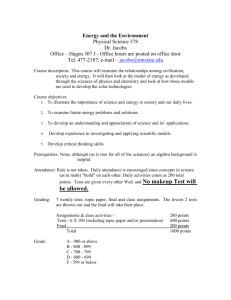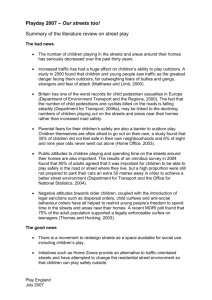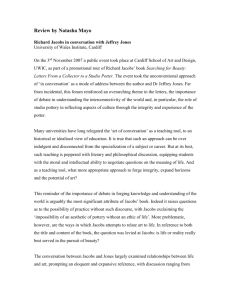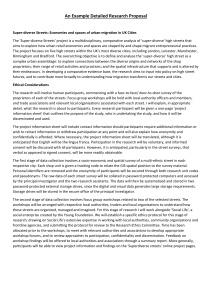Quotations - WordPress.com
advertisement
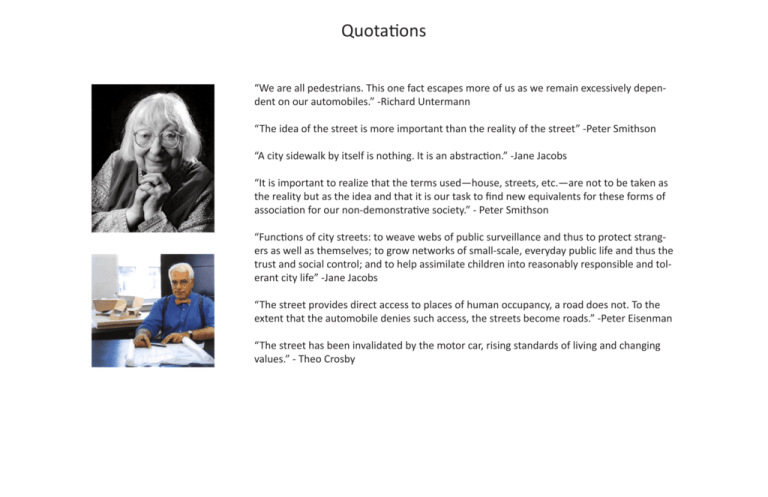
Quotations “We are all pedestrians. This one fact escapes more of us as we remain excessively dependent on our automobiles.” -Richard Untermann “The idea of the street is more important than the reality of the street” -Peter Smithson “A city sidewalk by itself is nothing. It is an abstraction.” -Jane Jacobs “It is important to realize that the terms used—house, streets, etc.—are not to be taken as the reality but as the idea and that it is our task to find new equivalents for these forms of association for our non-demonstrative society.” - Peter Smithson “Functions of city streets: to weave webs of public surveillance and thus to protect strangers as well as themselves; to grow networks of small-scale, everyday public life and thus the trust and social control; and to help assimilate children into reasonably responsible and tolerant city life” -Jane Jacobs “The street provides direct access to places of human occupancy, a road does not. To the extent that the automobile denies such access, the streets become roads.” -Peter Eisenman “The street has been invalidated by the motor car, rising standards of living and changing values.” - Theo Crosby Quotations (Cont.) “It [is] that new methods of production, new forms of transportation, and new ways of life demanded new forms of habitation, and that in turn cities would have to be transformed.” -The Smithsons “In 1915 the public pedestrian way had shifted in conception to become part of the building. it is important to note that when this shift occurs it modifies the form of the building.” -Peter Eisenman’ “The truly great street is one that is representative: it is the epitome of a type; it can stand for others; it is the best.” -Allan Jacobs “ In a very elemental way, streets allow people to be outside. Streets are what constitute the outside for many urbanites.” -Allan Jacobs “ There are aspects of the street that is measurable, the physical and aspects that are immeasurable, the socioeconomic.” -Allan Jacobs The best streets are those that can be remembered. they leave strong, long-continuing positive impressions. -Allan Jacobs “ The people of cities understand the symbolic, ceremonial, social, and political roles of streets, not just those of movement and access.” -Allan Jacobs Precedents of Inspiration Hong Kong Shanghai Las Vegas Precedents from Research Images from TP2 Images from TP2 (Cont.) Bibliography Anderson, Stanford. “On Streets.” Cambridge, MA: MIT, 1986. Print. Daniels, Eve. “ Skywalking: An Inside Look at the Interstates of Downtown Minneapolis,” The Next American City 9. 2006. Huevel, Dirk van den. “Alison and Peter Smithson-from the House of the Future to a House of Today. Rotterdam.” 2004. Jacobs, Allan B. “Great Streets.” Cambridge, MA: MIT, 1995. Jacobs, Jane. “The Death and Life of Great American Cities. New York: Modern Library, 2011.” Print. Peter Eisenman. “From Golden Lane to Robin Hood Gardens. Or If You Follow the Yellow Brick Road, It May Not Lead to Golders Green,” Peter Eisenman Inside Out: Selected Writings 1963-1988. Yale University Press, New Haven, 2004, pp. 40-56. Powers, Alan. “Robin Hood Garden: A Critical Narrative.” In Alison and Peter Smithson: A Critical Anthology, 228-245. Barcelona: Ediciones Poligrafa, 2011. Robertson, Kent A. “Pedestrinization strategies for downtown planners.” Journal of the American Planning Association 59, no. 3: Academic Search Permier, EBSCOhost. Rotmeyer, J. “Can elevated pedestrian walkways be sustainable?” The Sustainable City IV: Urban Regeneration and Sustainability. (Ashurst Lodge, Ashurst, Southampton: WIT Press, 2006), 293-301. Smithson, Alison and Peter. “The Charged Void: Architecture.” New York: Monacelli, 2001. Smithson, Alison and Peter. “The Charged Void: Urbanism.” London: The Monacelli Press, 2005. Southworth, Michael, and Eran Ben-Joseph. Streets and the Shaping of Towns and Cities. Washington, DC: Island, 2003. Print. Untermann, Richard K., and Lynn Lewicki. Accommodating the Pedestrian: Adapting Towns and Neighborhoods for Walking and Bicycling. New York: Van Nostrand Reinhold, 1984.


